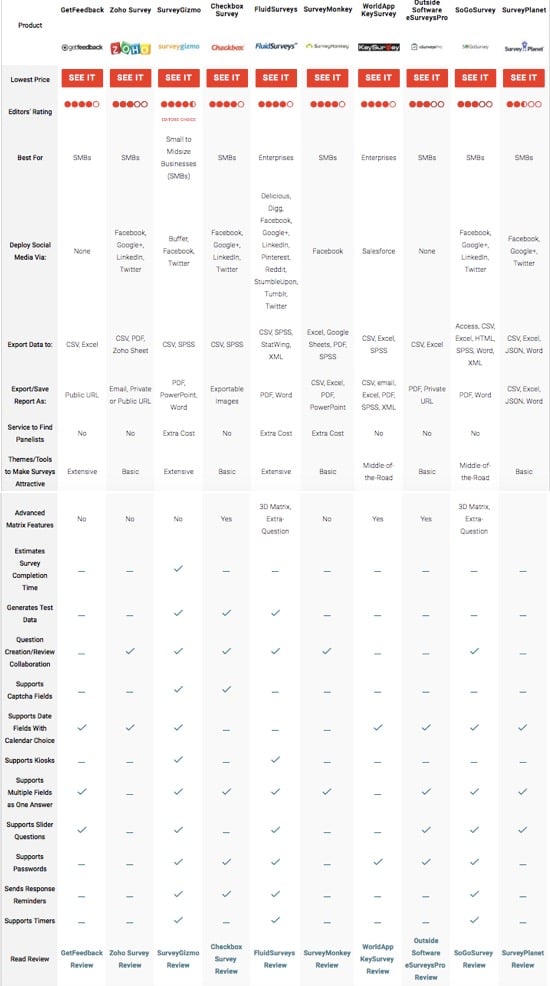
One of the most effective ways to connect with your customer base is using online survey tools. Market research statistics can provide meaningful insight into details about a market, strategies, and customers.
An online survey can help customer relationship representatives gauge customer satisfaction, solicit information from existing or prospective customers, or help human resources professionals learn what matters to employees.
In 2018, PCMag evaluated 10 of the most popular survey tools: Campaign Monitor GetFeedback, Checkbox Survey, FluidSurveys, Outside Software eSurveys Pro, SoGoSurvey, SurveyGizmo, SurveyMonkey, SurveyPlanet, WorldApp KeySurvey, and Zoho Survey. All of them guide you step by step through creating a survey, sharing the survey and evaluating the results.
However, SurveyGizmo stood out from its competitors; each feature did things a bit better than its competitors. For instance, its mobile support included a mobile preview, provides a survey time estimate, and branching logic doesn't require a jump to a new page.
Plan Your Survey
Throwing a survey into web space isn't nearly as effective as when you spend time to target a specific audience of interest. In fact, once you've got a better idea of who'll be taking your survey, you are able to better frame your questions as you'll have a more focused idea of what kind of information you want to receive.
This is the time you should also consider what form your survey will take. Generally, for an electronic survey, you'll be choosing between an email and a web survey.
An important new deployment target is the mobile device. According to a study from Greenbook that had more than 1.5 million respondents, more than 19 percent of today's online surveys are completed on a mobile device. Creators of online survey tools are responding. Companies like SurveyMonkey designed entirely new interfaces incorporating new capabilities; and it’s not just mobile but also includes artificial intelligence (AI).
It's How You Ask the Question
The heavy lifting usually goes into the process of building your survey. These apps can't help you decide what to ask, but they all help you define how to ask it (different ways to present questions). Besides the traditional single or multiple-choice check box, a drop-down menu, or a text box for "essay questions”, these tools offer many more options, from ranking questions ("On a 1-5 scale, where 5 is awesome and 1 is kill-me-now…") to matrix choices (one answer per row).
Every online survey app lets you skip questions or otherwise perform survey logic (at least, once you pay for a subscription; the free versions have feature limitations). The complexity of survey logic is in the "you get what you pay for" department.
How You Deploy the Survey
In the simplest case, you just need a URL to include in an email message along with hand-constructed text like, "Help us decide which location to choose for our user research conference!"
To get customers' attention, that email message needs to be catchy. You might also need to track participation and to send reminders to those who didn't respond.
Result Analysis
Every one of these tools does an admirable job at presenting the results in pretty charts and graphs. Some do impressive things with their analysis, however, such as SurveyGizmo performing text analysis on open-ended questions or Checkbox Survey automatically sending an email to a designated ID based on a survey response (such as a poor mark for customer service).
The tab below, provides an overview of the features embedded in each one of the 10 tool evaluated by PCMag.

Source:https://www.pcmag.com/article2/0,2817,2494737,00.asp (PCMag)
Let’s look at the top 3 tools that are currently available.
Survey Gizmo
The Basic version at $25 per month gives you styling options, survey logic, and the question library. An $84-per-month Standard version adds email campaigns, custom scripts, and more analysis tools. For larger teams who want such niceties as multi-user support and third-party integration, a "Market Research" license is billed annually and comes out to $125 per month.
In terms of customization, SurveyGizmo lets you control appearance on a desktop PC, tablet and phone and has lots of themes that go beyond typefaces and background colors.
When the survey logic suggests questions be displayed only to certain respondents, the additional questions pop up on-screen in the same page. Other tools require you to direct respondents to a separate page.
SurveyGizmo also has several ways to track who completed the survey. For example, you can create an email campaign with HTML messages. The campaign sends a unique link to each contact (populating the contact list using a spreadsheet), so you can track each contact's progress, send reminders to those who didn't complete, and email a thank-you to those who did.
You can also share the survey on Facebook, Twitter, and Buffer; print a QR code. If those don't generate enough responses, the company offers also an extra-cost service to help you find panelists.
SurveyGizmo makes it easy to analyze the results, too, tracking information that other tools don't, such as the average time people spent answering the survey, or the breakdown of mobile vs. desktop respondents.
Survey Monkey
SurveyMonkey has two pricing options at $19 or $25 per month. The latter provides such features as data and report export, A/B testing, answer randomization, and text analysis.
A great feature of SurveyMonkey is that allows you to insert piped text (e.g.: if Question Four was a multiple-choice for favorite colors [red, blue, yellow], Question Five can ask, "Why did you prefer red?" and Question Seven's multiple-choice options can include [favorite color] as a response, so you can learn more about that red choice).
Once your survey is ready to share, you can send it via email or Facebook. Survey Monkey’s customization options for the email appearance are comparatively limited, even though you can schedule when to send the message, create a custom URL and accept or reject anonymous answers.
GetFeedback
The application is primarily designed to get feedback from people using mobile devices. It has a user interface (UI) meant to appeal to and attract participation from visually-oriented younger audiences.
All paid subscriptions (starting at $50 per month for the Professional plan) have unlimited surveys and unlimited questions per survey as well as mailing list encryption and data export. The number of responses per month is controlled by the amount you pay, so the least expensive supports 100 responses and the top level supports 10,000. The Advanced plan ($150 per month) adds team collaboration, priority email support, and advanced logic.
GetFeedback approach is great for short surveys with a handful of items to rate. But, if you have a long list of detailed options followed by 20 other attributes, it's not the optimal solution.
Launching the survey gives you a URL to share—and it's up to you to share it. You can embed the survey on a website but there is no other social media integration.
After the survey is launched, you receive an email update every day telling you how many new responses were processed.
Google Forms
Finally, let’s not forget about Google Form. Much like the other tools Google offers, Forms lets you easily accomplish what you want – in this case, collect online survey responses. It’s completely free and has no restrictions on the number of surveys you can create, the number of questions in each survey, or the number of responses you can collect. You can also automatically export your results to Google Sheets for online access and sharing. You can even add collaborators and embed surveys into emails.
However, compared to the other survey tools Google form has several limitations:
- Can be completed as many times as a person wants to access the survey.
- No ability to format text
- Hardly any ability to move questions other than up or down.
- No ability to insert logic in the survey questions
In conclusion, it’s there is great variety in survey tools offered to the and each of these tools has its specific focus (mobile vs tablet vs desktop, online vs offline, easy and straightforward vs complex logic in the question flow).
Thanks to these tools, companies are able to gain a deeper understanding of their customers’ tastes and opinions, being able to reach a broader audience at a lower cost.
READ MORE: Choosing the Right Survey Tools for Quantitative UX Research, Survey Design Sins to Avoid, Strengths and Weaknesses of a True Intent Study, Tips to Recruit Participants for Usability Testing










Comments
Add Comment